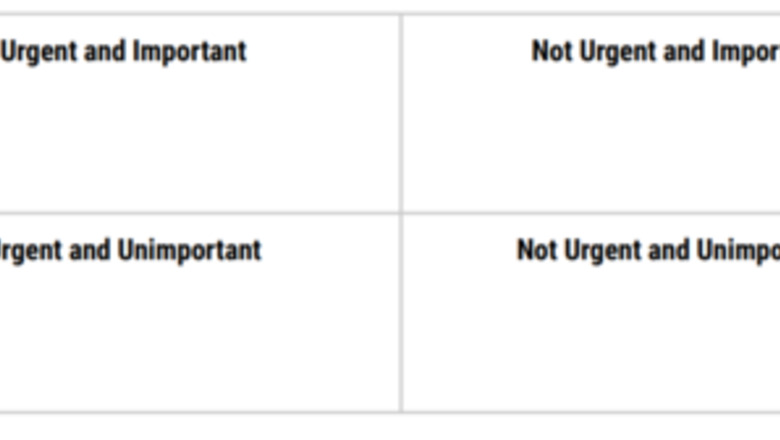
views
Write down everything you need to do for the week or month. Getting all your tasks out of your head and onto paper is the first step to feeling organized and in control. Example for a novice student: list all your homework and study dates, get everything laid out, and add the due dates next to the tasks. Example for an adept student: write down your specific daily tasks and even include your bigger goals that you haven’t been able to get to. Make sure to include all your due dates with all your tasks and goals. Remember to not get stressed out when seeing everything laid out in front of you, it will all be completed once you use the Eisenhower Matrix.

Create a 2x2 grid. You should then make a grid and split it up into four boxes that prioritize your tasks. Split your paper into four boxes and label from left to right: "Urgent and Important", "Not Urgent and Important", "Urgent and Unimportant", and not "Urgent and Unimportant".

List appropriate tasks under the "Urgent and Important" category. In the box labeled "Urgent and Important", you will list all of the tasks you have with set deadlines and significant consequences if not completed on time. Example for a novice student: Think about all the tasks that you need to complete that have specific deadlines that you cannot miss! It could be homework assignments, discussion posts, quizzes, or tests. To make sure you stay on your tasks you should evaluate what could potentially happen if you do not complete your tasks. It would be best to do this every week, so you will have built a routine. Example for an adept student: make sure you're putting your focus on tasks that have strict deadlines. You can set reminders and use different tools to check your progression for your tasks.
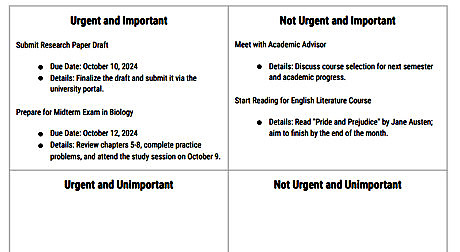
List appropriate tasks under the "Not Urgent and Important" category. In the box labeled "Not Urgent and Important", list all the tasks you have that do not have a set deadline but will lead you to your long-term goal (e.g. taking notes). Example for a novice student: These tasks are important for your growth as a student but not urgent because there is no specific deadline, these could be tasks such as studying or going over notes. Example for an adept student: For these tasks you should still look at them as important, completing these tasks helps you as a student. They may not have a deadline but they are still important to finish.
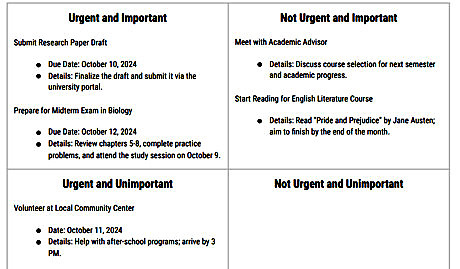
List appropriate tasks under the "Urgent and Unimportant" category. In the box labeled "Urgent and Unimportant", you should put all the tasks that need to be done but do not need your expertise to be completed. Example for a novice student: Think about all the tasks you have to get done, they might not need you to complete them yourself. This may be for things that lie outside of your coursework, but that are still important enough to be completed on time. You may need to find someone reliable to delegate your tasks to. Make sure if you do, you provide them with clear instructions on how to help. Example for an adept student: these tasks are things that you need to complete but not in a specific timeline. They typically are tasks that do not have a due date but they are important for you to do and should be prioritized.
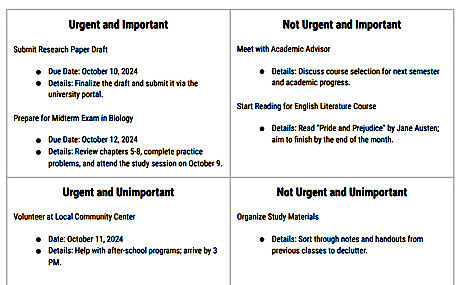
List appropriate tasks under the "Not Urgent and Unimportant" category. In your last box labeled "Not Urgent and Unimportant", put all the tasks that would distract you and do not hold any value. Example for a novice student: These are the tasks that you are going to complete last, once all the other tasks are completed. They are the ones you typically put on the back burner but the Eisenhower matrix is going to make sure you complete all your tasks, even the ones that aren’t urgent or important! Example for an adept student: the non-urgent and non-important tasks are the tasks that typically get pushed off because there are so many tasks that have such urgency and importance. Using the matrix will allow you to still prioritize these tasks and have them written down.
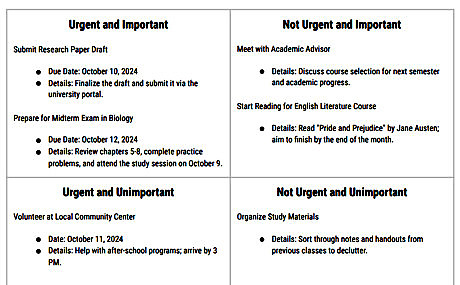
Begin using the grid you just completed. Start on your assignments that are listed under the most Urgent/Important and work through all the assignments based on urgency. Example for a novice student: Begin using the matrix, starting with important and urgent, then completing urgent but not important, next doing the important but not urgent tasks and lastly completing the not important and not urgent. Get all your tasks and work done and check/cross off the tasks after doing each thing. Example for an adept student: now you may use the Eisenhower matrix! You should start by completing the important and urgent, you should then complete the urgent but not important, then go to important but not urgent, and lastly the not urgent and not important. Do not get overwhelmed by the amount of work you may have: the Eisenhower matrix will allow you to work promptly and be more organized!




















Comments
0 comment